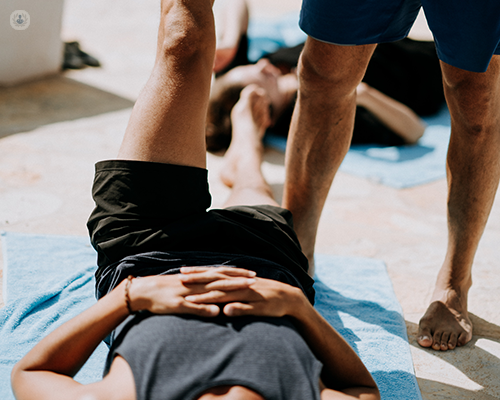Hip arthroscopy: pathologies, expectations and risks
Autore:A hip arthroscopy is a surgical procedure used to diagnose and treat several hip joint pathologies such as labral tears. Mr Seb Sturridge, leading orthopaedic surgeon with expertise in hip arthroscopies, provides a comprehensive view of the procedure and explains what patients can expect.

What pathologies can a hip arthroscopy address?
Using a minimally invasive technique, a hip arthroscopy is a means to assess and treat the hip joint which enables a quicker recovery and return to work. While the technique can address intra-articular hip pathologies including labral tears, osteochondral defects, hip impingement and loose bodies; a hip arthroscopy can also target extra articular soft tissue pathologies such as psoas tendonitis, bursitis and gluteal tendinopathy.
Most commonly, patients present with groin pain due to a labral tear aggravated by twisting or impact sports, which can start to impact a patient’s ability to run, walk and sleep.
What can patients expect before and after surgery?
A clinic consultation would generally start with a series of questions to assess the degree of pain and the impact it is having on a patient’s activity level. To confirm the cause of the pain, these questions are followed by a clinical examination of the hip so please come dressed appropriately. An X-ray is a readily available investigation which can demonstrate most hip pathology, and you may be requested to have one just before your appointment if you haven’t had one before. Depending on the working diagnosis, you may need to go on to have an ultrasound, a CT or an MRI scan. MRIs can sometimes help surgeons assess pre-arthritic conditions further.
A patient may then be admitted as a day case if the cause of the hip pain can be addressed with hip arthroscopy. General anaesthetic will allow the muscles around the hip to relax and the hip to sublux under traction, which will enable the central compartment of the hip joint to be examined arthroscopically and a labral tear to be debrided or repaired. The causative bone can be burred back if the hip is impinging, to reduce the risk of ongoing hip impingement.
Due to the water used to inflate the joint during the arthroscopic examination, patients will usually wake up with swelling in their leg after the surgery. Crutches may be necessary for two days and the physiotherapist will have explained how to manage them in the pre-operative phase. The physiotherapist will also give patients exercises to help rehabilitate the hip. To prevent stiffness due to surgical scarring, patients are advised to start gentle early range of movement exercises immediately postoperatively.
Regarding work, most patients are advised to take two weeks off with some patients working from home in the second week. This is to prevent early complications such as bleeding or pain caused by an attempt to return to work too early. It is worth for patients to discuss a staged return to work with an employer if their work is mostly manual.
Low impact exercises, such as static biking and swimming, should be appropriate to do from two weeks after surgery. Day to day activities and the gym should feel almost normal by four to six weeks. If a patient is able, they can progress on to cross training and a treadmill later on. By three months, the majority of patients will have returned to their expected level of physical activities.
Due to worries about the ability to make an emergency stop, patients shouldn’t be driving while they are using crutches to walk. Patients should be safe to drive when they are able to walk on their own and can climb into and out of a car comfortably. Patients should also contact their insurer if they’re planning to drive soon after surgery so that the insurer is aware and prepared to cover them in case of an accident.
Up to three months after surgery, there exists a potential increased risk of suffering thromboembolism (blockage of a blood vessel by a blood clot) due to flying, depending on the length of flight and a patient’s pre-existing risk factors. It might be worth for patients to consider anticoagulants if they’re thinking about taking a long-haul flight within six weeks of surgery, to reduce the risk of thromboembolism.
What are the complications?
Although surgical procedures have become safer and complications are rare, risks still exist. Infection, venous thromboembolism, blood vessel and nerve injury are general complications of any surgery. However, there are also complications specific to this type of surgery such as paraesthesia (numbness) which can affect the perineum, lateral thigh and foot as a result of the necessary traction to distract the joint during surgery, which we manage by minimising traction times.
Mr Seb Sturridge is a leading orthopaedic surgeon based in Farnham and Guildford who specialises in hip and groin pain and sports related hip injuries using minimally invasive techniques. If you require a hip arthroscopy and wish to discuss your options, don’t hesitate to visit Mr Sturridge’s Top Doctors profile today.


